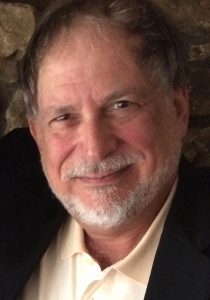
UM music instructor Stanley Friedman wrote ‘Sojourner Truth: A Cantata’ on commission from Nicholls State University. Submitted photo
OXFORD, Miss. – Stanley Friedman didn’t learn about Sojourner Truth growing up. “It just wasn’t taught in segregated white schools in Memphis in the ’50s and ’60s,” said the composer, who teaches composition in the University of Mississippi Department of Music.
Upon later discovering this fiery abolitionist and early proponent of women’s rights, Friedman knew he wanted to create a work inspired by her life and words. The music faculty at Nicholls State University in Louisiana approached Friedman about commissioning a work from him, and he was confident that Sojourner Truth would be a great fit for their musicians, including Valerie Francis, a strong soprano.
The resulting work, “Sojourner Truth: A Cantata,” will be performed by the Sojourner Truth Ensemble of Nicholls State at 2 p.m. Sunday (Feb. 24) in Nutt Auditorium. The performance is part of the UM observance of Black History Month, and admission is free.
Although people may associate cantatas with J.S. Bach, who composed more than 200, Friedman’s piece sounds decidedly modern, which is appropriate for an exploration of Truth, even though she lived primarily in the 19th century.
“We don’t have as much history from this period from the African-American perspective,” Friedman said. “Mostly we hear that the generals did this, and Lincoln did that.
“But the truth is that slaves, and freed slaves and free blacks were hardly passive. Sojourner Truth, in particular, was proactive, and was an extremely modern-thinking woman.”
Friedman uses the typical five-movement cantata form to explore five moments in her life. The first movement describes how Truth came to be. Although details about her life vary, scholars agree that she was born on a Dutch plantation in New York State as Isabella Baumfree and actually spoke Dutch in her early years as a slave.
New York abolished slavery in 1827, and as Baumfree gained her freedom and began a series of jobs, she focused on reuniting her family. She’d had five children, and all were sold; her last child was sold after 1827, so she successfully sued for his return.
It was the first instance of a black woman suing a white man in a U.S. court.
The text to the cantata’s first movement explores the moment when she decided to change her name from Isabella to Sojourner. She chose Sojourner because, having found a deep faith, she felt called to a traveling ministry, and Truth because she would speak the truth to the people about the reality of slavery.
The second movement skips ahead to the Civil War years, which found Truth in Washington, D.C., recruiting black men to fight for the Union. The music in this movement is inspired by Civil War-era marches, as Truth exhorts the soldiers to fight for the freedom of their Southern brothers and sisters.
During these years, Truth also cared for wounded soldiers and met with Abraham Lincoln at the White House.
The third movement, the centerpiece of the entire composition, takes its text from Truth’s famous “Ain’t I a Woman” speech. At nearly eight minutes, it is the longest section and the most deeply emotional.
“Her language is powerful, emotional, heartbreaking,” Friedman said. “People may be familiar with the one phrase, ‘Ain’t I a woman,’ but the rest of the speech is incredibly heartbreaking.
“It starts gently, ‘Look at me, look at my arms. I have plowed and planted, no man could best me. I could work and eat as much as a man, and ain’t I a woman.’ The mood turns to righteous indignation: ‘I could bear the lash as well as any man. I have born five children and seen them sold off to slavery, I cry out and only Jesus hears me,’
It’s ravaging. If I could put it into words, I wouldn’t need to write the music.”
The fourth movement deals with the end of Truth’s life, when she was quoted as saying “I’m not going to die; I’m going home like a shooting star.”
The fifth movement in a cantata is traditionally a choral piece, but Friedman decided to delve into Truth’s ministry, her preaching and sermonizing, and so composed an original gospel tune. In this movement, Truth speaks to America.
“Where will you be when eternity begins with all your guilt and all your sins?” Truth asks. “I’m the seed of the free and will bear great fruit.” In closing, she asserts, “I’m going to make this nation rock like a cradle.”

Soprano Valerie Francis sings the role of Sojourner Truth in Sunday’s performance of ‘Sojourner Truth: A Cantata.’ Submitted photo
“She wanted to shake everybody up, which she absolutely did,” Friedman said. “To me, her words and her attitude echo so strongly today, they reverberate across the years.”
“Sojourner Truth: A Cantata” features soprano Valerie Francis with Nicholls State musicians Matthew Swihart, on trumpet; Michael Bartnik, clarinet; Jason Ladd, tuba; Gustavo Miranda, percussion; and Shane Anderson, piano.
“Dr. Friedman has created an extraordinary piece of music by blending his musical language with the genre of the African-American spiritual and a bit of gospel style,” Anderson said. “The opportunity to learn and perform such a meaningful work has been particularly rewarding for our faculty and students at Nicholls.”
For his part, Friedman is humbled by what he has learned about Truth and, as a white man, is grateful for her work and inspiration.
“Hers is an African-American story, of course, and an American story, and it’s also a story that transcends her time and place – it’s a human story,” Friedman said. “Wherever oppressed people rise up to claim their rightful place in society and under the law, to me, that’s what Sojourner is about.”